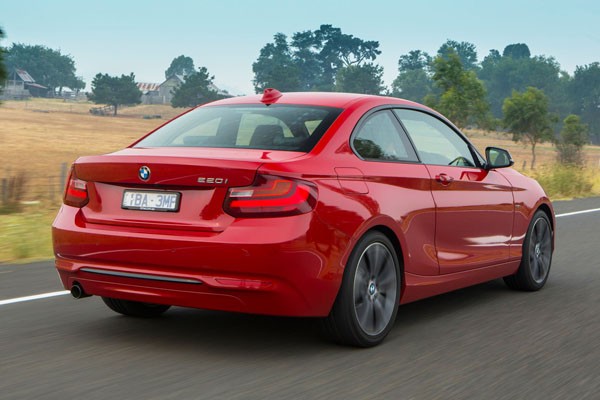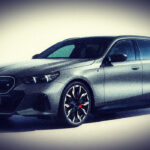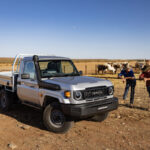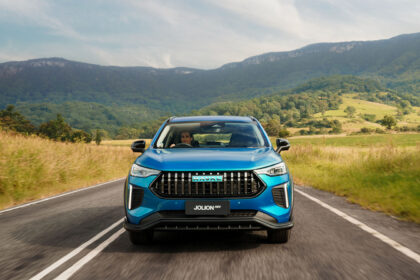
Prestige German car companies continue to introduce relatively low cost models, planning to sign up customers that will develop a lifelong loyalty to the brand and, hopefully, upgrade to expensive higher-profit models later.
The latest automobile manufacturer to do this is BMW which has just released its first Series 2 coupe, which brings a new level of driving dynamics to the premium compact segment.
With a heritage in the segment with the likes of the two-door 2002 turbo of the 1960s, and more recently the multi-award winning 135i Coupe, the new Series 2 coupe carries on the three-box tradition with a long bonnet, short overhangs, set-back passenger cabin and sleek roof line.

Bigger than the model it replaces, the 2 Series coupe is 4432 mm long (+72 mm), 1774 mm wide (+26 mm) and is 5 mm lower (1418 mm). The chassis has gained 30 mm in its wheelbase, plus a wider front (+41 mm) and rear (+43 mm) track.
Three models make up the new 2 Series range – two petrol and one diesel powered – featuring the latest BMW TwinPower turbocharged engines producing dynamic performance and outstanding fuel economy, the latter not the only attractive saving.
The entry-level model, tagged 220i coupe, comes to market from $50,500, plus on-road costs, the 220d coupe from $52,500, while the 235i tops off the range at $79,900.
BMW 220i coupe is powered by a 2.0-litre four-cylinder motor with twin-scroll turbocharger putting out 135 kW of power and 270 Nm of torque, the latter from a very low 1250 rpm. That’s enough to have the car up to 100 km/h from rest in 7.0 seconds. Official fuel consumption is a frugal 6.0 litres of petrol per 100 kilometres.

The 220d also comes up with 135 kW of power, this time from a four-cylinder turbo-diesel engine. Torque is a generous 380 Nm; acceleration is 7.1 seconds to 100 km/h and fuel consumption is listed at a miserly 4.4 litres per 100 kilometres.
The top dog 235i coupe becomes BMW’s most powerful M Performance vehicle, with 240 kW of power and 450 Nm of torque coming from its six-cylinder, in-line, 3.0-litre M TwinPower turbo. This has the car sprinting to 100 km/h in just 4.8 seconds.
All variants are fitted with BMW’s eight-speed sports automatic transmission with steering wheel-mounted shift paddles and launch control, while the 220i and 220d boast identical top-notch specifications.
Standard are rear park distance control, halogen headlights with auto control and rain sensor. Occupants enjoy automatic climate control air-conditioning, sun protection windows and sensatec upholstery on sports seats, 60:40 split rear seats as well as a swag of storage space.
The six-speaker audio has auxiliary and USB inputs, Bluetooth is on tap with voice control, audio streaming and pairing of multiple devices. All cars cars have standard satellite navigation using a 6.5-in high resolution colour screen.
Safety features include dynamic stability control, dynamic brake lights, eight airbags and an active bonnet for pedestrian protection. Standard, Sport Line or Modern Line packages add further individuality to the variants.
The 235i coupe, as befits its position at the top of the tree, stands out from its siblings with distinctive exterior features that pay homage to its sporting pedigree. These include full M Sport aerodynamics, with ferric grey mirror backings, kidney radiator grille with eight vertical slats in high-gloss black.
Dark blue callipers of the M sport brakes are on show through 18-inch double spoke M alloy wheels on which the 235i rides. However, it is at the rear that the 2 Series coupe disappoints.
From the back the car is a disappointment to my eyes. Altogether bland, a horizontal crease below the boot lid spoiler looking as if it had been shunted from behind by a vehicle fitted with a bullbar.
Occupants enjoy a level of specification not found in BMW 235i coupe’s siblings. Included are front park distance control, Bi-Xenon headlights, upgraded satellite navigation, iDrive controller, internet access and seven-speaker 205 W audio system.
A plethora of option packages are available for buyers to further add individuality to their vehicles. These include Advanced Parking Package, Visibility Package, and Comfort Package.
One system that rates special attention, however, is the Driving Experience Control, something that was extensively examined during the 2 Series launch in Tasmania, which included sections of the Targa Tasmania and track modules at Baskerville Raceway, near Hobart.
This system has the ability to alter suspension, accelerator mapping and steering response by means of a switch on the centre console. Settings range from Comfort, Sport, Sport+ and Eco Pro.
On the road drive, Comfort mode helped soak up some of the potholes and undulations in the road surface while ‘relaxing’ the acceleration and steering sharpness.
Sport sharpened the steering and power, and dealt out a firm ride allowing bends and corners to be taken speedily yet safely. Most noticeable was the absence of body roll whatever the car was called on to deliver.
Sport+ was left strictly for track work, with little unsettling the 235i coupe in manoeuvres not normally in the realm of the road car. Adaptive M suspension and variable sport steering also enhanced the agility and performance of the 235i Coupe.
The new BMW 2 Series will appeal to young singles or marrieds with no children who can to get a taste of what BMW has to offer in its range of more expensive driver-oriented premium products.
BMW may be surprised to find it is hard to prise these folk away from their entry-level compact coupes. The cars are so satisfying. Bang goes plans to sell them up to the higher-profit models. Ah well, that’s up to the sales people…
MODEL LINE-UP
BMW 220i Coupe: $50,500 (automatic)
BMW 220d Coupe: $52,500 (automatic)
BMW 235i Coupe: $79,900 (automatic)
Note: These prices do not include government or dealer delivery charges. Contact your local BMW dealer for driveaway prices.










